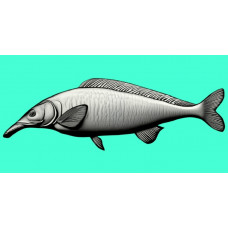Latin name
Campylomormyrus numenius
Other name
Gnathonemus numenius
Identification
Campylomormyrus numenius possesses a highly elongated, ventrally curved rostrum, analogous to an elephant's trunk, terminating in a small mouth with a mobile, finger-like appendage on the lower lip.
Features of fish fins
Dorsal spines (total): 0; Dorsal soft rays (total): 31; Anal spines: 0; Anal soft rays: 35.
Fish colouring
The body coloration is brown, with a lighter, often cream-colored ventral surface.
Distribution
Endemic to Africa, this species is documented in the Malebo Pool basin, the middle reaches of the Congo River and its northern tributaries, as well as the Lualaba River system within the Democratic Republic of the Congo.
Habitat
A tropical, freshwater, benthic species restricted to large, high-discharge river systems.
Size
Males can reach a maximum total length of 65.0 cm and a mass exceeding 1 kg.
Behavior
This species is noted for its well-developed electrogenic and electroreceptive capabilities. It possesses a specialized organ near the caudal peduncle that generates a weak electric field (approximately 6 volts), functioning for active electrolocation. Discharges from this organ create an electromagnetic field around the fish; any object with different conductivity than the surrounding water distorts this field. These distortions are detected by electroreceptors distributed on the skin, primarily along the dorsal region. This system provides a high-resolution perception of the environment, allowing the detection of minute objects, such as sediment particles or potential prey, and contributes to exceptionally low bycatch rates in seine netting. Historical superstitions among local populations, which attributed a "visual" capability to the tail, are likely rooted in observations of this unique sensory adaptation.
Food and feeding habits
A nocturnal species, C. numenius is typically associated with littoral zones featuring dense aquatic vegetation, such as papyrus, lotus, and water lilies. It is a benthic feeder, foraging in the substrate for infauna, primarily consuming annelid worms and insect larvae, with a dietary preference for chironomids (Family Chironomidae).
Reproduction
Spawning is seasonal, coinciding with the rainy season. Key environmental cues triggering reproductive behavior and migration include a decrease in water pH, an increase in dissolved humic substances, and movement into smaller, shallower tributary streams.
Fishing
This species is not commercially important.
Relationship with a person
Harmless. The flesh of these fish is considered palatable and is a rich source of protein.
| Classification | |
| Phylum | Chordata |
| Class | Actinopterygii |
| Squad | Osteoglossiformes |
| Family | Mormyridae |
| Genus | Campylomormyrus |
| Species | C. numenius |
| Features | |
| Conservation status | Least Concern |
| Habitat | Bottom |
| Life span, years | No information |
| Maximum body weight, kg | 1 |
| Maximum length, cm | 65 |
| Sailing speed, m/s | No information |
| Threat to people | Edible |
| Way of eating | Bentophage |
Campylomormyrus numenius
Tags: campylomormyrus numenius

